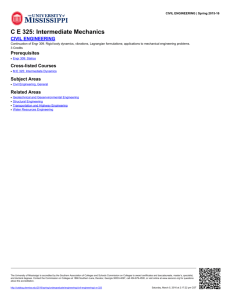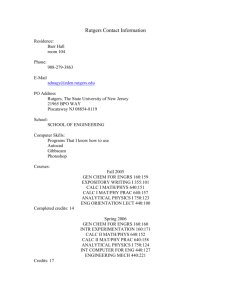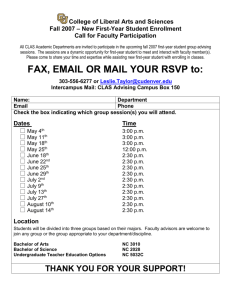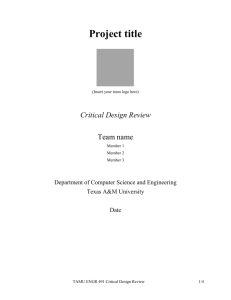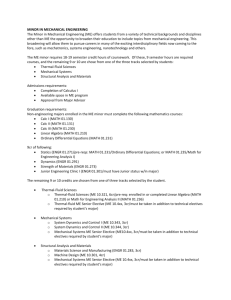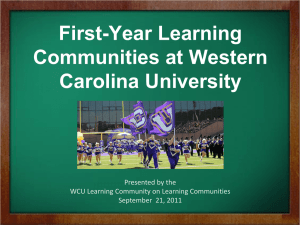Getting Faculty to Change, Possible or Not?
advertisement
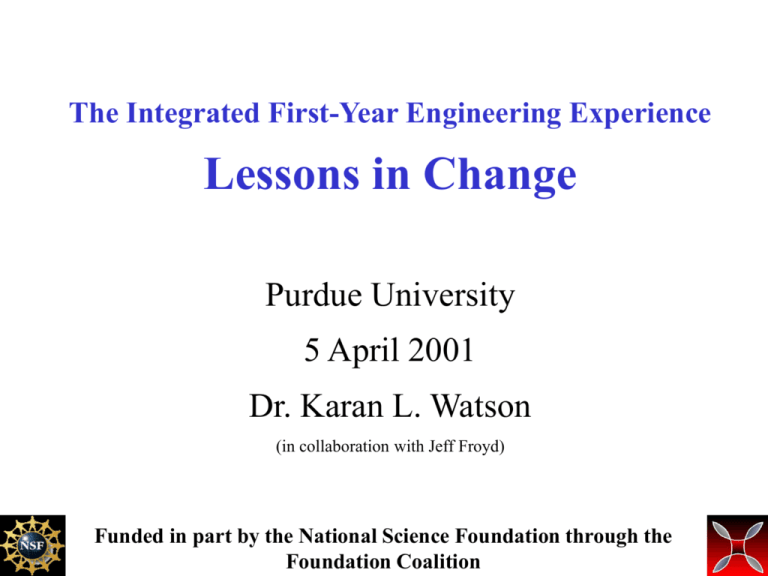
The Integrated First-Year Engineering Experience Lessons in Change Purdue University 5 April 2001 Dr. Karan L. Watson (in collaboration with Jeff Froyd) Funded in part by the National Science Foundation through the Foundation Coalition Presentation • Case Study- TAMU’s Integrated First-year • Ideas about change- How should we model the process of change • Major components of the Change Model • Discussion Texas A&M University CURRICULUM INTEGRATION changed first- and second-year engineering, math, physics and chemistry for all students (6 coordinators) upper-division changes in CVEN, PETE, INEN, AERO, MEEN TEAMING & ACTIVE LEARNING faculty workshops, student profiles, industry diversity training TECHNOLOGY ENABLED ROOMS 13 redesigned classrooms Texas A&M University INCLUSIVE LEARNING COMMUNITIES Clusters- 70% first-year students & 25% secondyear students, 94 faculty members Industry case studies with all first-year students Group Study Workshops ASSESSMENT & EVALUATION New professional staff, focus on faculty needs in course revisions Texas A&M University Performance Benefit: Grades & Standardized Tests When compared to equivalent students in traditional engineering programs, after one year, students in the new curriculum perform better on standardized tests and better in grades for follow on courses. Test % Gain Greater than Traditional 16% Standardized Critical Thinking Force Concept Inventory 15% 10% Mechanics Baseline Test Calculus Concept Test 10% 0 5 10 15 20 W W hite hi te M a Af Fe le s Af r.-A ma r.- m le Am . M s . F ale La em s La tino ale tin M s a a Fe les O m t O her ale s th er Ma Fe les m al es % Retained in Engineering Texas A&M University FOCUS ON UNDER-REPRESENTED GROUPS Better retention 100% 90% 80% 70% 60% 50% 40% 30% 20% 10% 0% Traditional FC TAMU Integrated First-Year Curriculum Concerns Pilot section size 1994-95 Pilot: 50 students per section 1995-96 Pilot: 100 students per section Dividing four hours of PHYS 218 (Mechanics) across two semesters was not a good idea. Students seemed to pay more attention to the MATH 151 course (a four-hour course). 1994-95 Pilot PHYS218 (Mechanics) across two semesters 1995-96 Pilot: PHYS218 (Mechanics), Fall Semester (3 credits instead of 4) PHYS 208 (E&M), Spring Semester (3 credits instead of 4) Overloading students Physics laboratories were done in-class using a “studio-like” approach. $$$$$ TAMU Integrated First-Year Curriculum Concerns Flexibility The availability of opportunities to students to “leave” the integrated curriculum without major penalties. An intervention program was offered to students who were failing in some of the subjects [9] but the cost and energy required to run this program was also questioned. The lack of participation by the pre-calculus, honor students, and students who placed out of courses in the integrated program. Faculty and administrators were very concerned about the “platform independence” of the piloted program. Could only those “zealots” teach it? How will engineering faculty be selected for participation? Chemical Engineering Department was concerned about the one-semester chemistry course TAMU Integrated First-Year Curriculum Visualization of Momentum 1993 1995 1997 1999 NSF Funding Larger pilot Decide 1994 1996 1998 Formed Team Stable Team Form Eval Tm. Large Team Init. Planning Implementation Pos. Results Chng Team New pilot Little new Excited Team Initial Planning Initial Results Excited Students Nothing’s Wrong Nothing’s Wrong Personalities Mom. To Change Personalities Workshops to Address Fears Nothing’s New Res. To Change Negative Anecdotes Personalities Poor Teaming Poor Advising Interface Emphasizing Values Negative Anecdotes Nothing’s Wrong Personalities Poor Advising Interface NSF Funding Nothing’s Wrong Personalities TAMU Integrated First-Year Curriculum Numerous Integrated Models to Serve Students Number of Entering Freshmen in Block Type Total Number of Incoming Students to First-Year Courses/Year 2060 2000 1600 1570 1520 1480 1420 1995 1996 1997 Pre-Calc AP Calc Honors No Phys Int No Engl Int Int Precalc Full Int Calc 1200 800 400 0 1994 1998 Numerous Integrated Models to Serve Students 500 PRECALC 1000 CALCULUS 1 300 BEYOND CALCULUS 1 Precalc, Chem, Engr 0 ( 300 ) Independent Courses ( 200 ) Calc 1, Phys 1, Engr 1, Engl 1 ( 100 ) Calc 2, Phys 2, Engr 2, Chem ( 300 ) Calc 1, Phys 1, Engr 1 ( 600 ) Calc 2, Phys 2, Engr 2 ( 200 ) Calc 1, Engr 1 ( 150 ) Calc 2, Engr 2, Chem ( 300 ) Independent Courses ( 150 ) Independent Courses ( 300 ) Calc 2, Engr 1 ( 50 ) Independent Courses ( 250 ) Clusters are offered to students at each level. Lessons from Foundation Coalition Curriculum Change Experiences • Focus on faculty behavior, not the curriculum or technology. • People outside the pilot groups need to be engaged from the beginning. • Assessment data is necessary but not sufficient. • Successful change requires energy and time. • Don’t become surprised or defensive when resistance appears. • Persevere through turmoil. • Zealous change champions cannot institutionalize the change by themselves. • Articulate an explicit process for the change. Change - What is it? Reasons to Change • Anxiety 1: Fear of learning something new; fear of changing, based on fear of the unknown. • Anxiety 2: Fear that if I don’t change and learn how to learn, things will go badly for me. • Proposition 1 About Learning Anxiety 2 must be greater than Anxiety 1. Schein, Edgar H., Organizational and Managerial Culture Change - What is it? Change: Ignorance to Action • Change occurs in stages • If you want to facilitate change, then you need to facilitate movement from one stage to the next. Don’t expect a person to change all at once. • Different people understand different things about change Change: Ignorance to Action Ignorance Passive Information Gathering Awareness Interest Decision Active Information Gathering Commitment Action Individual’s Approach to Change Energy for the Job Betrayal Search for Solution Denial Crisis Time Group’s Approach to Change Search for Solutions Identity Crisis Denial Betrayal TIME Concepts in Organizational Change Nature of Change Nature of Resistance Organizational Culture Leadership Change Dynamics Nature of Change • Who has to change? – – – – Behavior Attitude Belief Value • What is the timeline for change? • What are the available resources to fuel change? Nature of Change Profound Change “... we use the term “profound change” to describe organizational change that combines shifts in people’s values, aspirations, and behaviors with “other” shifts to processes, strategies, practices, and systems.... In profound change there is learning. The organization doesn’t just do something new, it builds its capacity for doing things in a new way--indeed, it builds capacity for ongoing change.... It is not enough to change strategies, structures, and systems, unless the thinking that produced those strategies, structures, and systems also changes.” Senge, Peter, et. al., The Dance of Change Nature of Change Adaptive Learning vs. Generative Learning • Adaptive Learning (Senge) / Single-Loop Learning (Argyris) – learning that increases the probability of survival, i.e., coping or survival learning – focus: solution to a problem – e.g., passing a test, problem solving, engineering design • Generative Learning (Senge) / Double-Loop Learning (Argyris) – meta-level: learning that enhances my ability to create – recursive: improving personal algorithms, models, processes – focus: increased personal capacity – e.g., reflection, learning to learn, learning to improve Senge, Peter, The Fifth Discipline Argyris, Chris, “Teaching Smart People to Learn,” Harvard Business Review Resistance • Resistance isn't an indication that something is wrong with what you are trying to change. It is an indication that something is happening. It is a good sign! If you treat everything you see as resistance, you can be wrong. It may be a lack of understanding of what you are doing as opposed to not liking what you are doing. The remedies for each are quite different. You will learn many important things from resistance, which will make your implementation planning go a lot smoother. James Hunt http://www.top7business.com/archives/management/20000208.html Jim Hunt, Principal James W. Hunt & Associates The "Change II" Management Consulting Firm Web address: www.jameswhunt.com Resistance • Resistance is inevitable, not bad – – – – People are at different stages in changing People move from stage to stage at different rates People move from stage to stage in response to different stimuli Resistance is similar to turbulence • Ignorance facilitates resistance; resistance facilitates ignorance • Responses to resistance – Dismissal: “You’re an idiot.” – Bulldozer: “You just don’t understand and I will try again to convince you of the correctness of my approach.” – Let’s talk: “What you say has merit. Let me understand your concerns and let’s review how an alternate proposal might address your concerns.” – Anticipate: Don’t be placed in a position of selling a curriculum proposal; instead position yourself as responding to a felt need Resistance How to Recognize Resistance • • • • • • • • • Confusion Immediate Criticism Denial Malicious Compliance Sabotage Easy Agreement Deflection (changing the subject) Silence In-Your-Face Criticism Maurer, Rick, Beyond the Wall of Resistance, Austin, Texas: Bard Press, 1996, chapter 2 How Intense is the Resistance • Level 1: The Idea Itself (primarily intellectual) – Communicating the Idea -- Relative Advantage -- Simplicity -- Compatibility -- Easy to Test – Involvement • Level 2: Deeper Issues (primarily emotional) – Listen for and address: Distrust, Bureaucratic Culture, Punishments and Rewards, Loss of Respect and Face, Fear of Isolation, Events in the World • Level 3: Deeply Embedded (viewed as enemy) – Pay attention and attend to issues around --Historic Animosity -- Conflicting Values and Vision Maurer, Rick, Beyond the Wall of Resistance, Austin, Texas: Bard Press, 1996, chapter 8 Response to Resistance What is your contribution to resistance? • “Everyone thinks of changing the world, but no one thinks of changing himself” Tolstoy • “We have met the enemy, and he is us” Pogo • “We must become the change we wish to see in the world.” Gandhi Response to Resistance Touchstones in responding to resistance • TOUCHSTONE NO. 1: Maintain clear focus – – • • TOUCHSTONE NO. 2: Embrace resistance TOUCHSTONE NO. 3: Respect those who resist – – – – • Struggle for respect Respect vs. trust Listen with interest Tell the truth TOUCHSTONE NO. 4: Relax – – • Keep both long and short view Persevere Stay calm to stay engaged Know their intentions TOUCHSTONE NO. 5: Join with the Resistance – – – Begin together Change the game Find themes and possibilities Maurer, Rick, Beyond the Wall of Resistance, Austin, Texas: Bard Press, 1996, chapter 5 Change and Resistance Commitment to Change Concerns, e.g., • Fear • Negative Assessment Possibly Improved Results New Learning • Zealot Arrogance Positive Impact Negative Impact What is it? Culture “Culture eats change for breakfast” James Hunt http://www.top7business.com/archives/management/20000208.html Jim Hunt, Principal James W. Hunt & Associates The "Change II" Management Consulting Firm Web address: www.jameswhunt.com What is it? Culture • Culture is the collection of lessons (which become unwritten assumptions) that a group has learned that have become applied so often that members of the group no longer question their correctness or even acknowledge their existence. “It just the way we do things here.” Frequently, these lessons were learned during the early history of the group and were often generated or espoused by its founder. – because it happened this way, it did not happen another way – because it was successful, it must have been the right way to do it • These lessons are communicated explicitly or implicitly to new members of the group. What is it? Levels of Culture • Artifacts – visible organizational structures and process – easy to observe, difficult to decipher, ambiguous • Espoused values, rules, behavioral norms – strategies, goals, espoused rationalizations – articulated reasons for actions, (theories of action, Argyris) • Basic underlying assumptions – unconscious, taken-for-granted beliefs – theories-in-use (Argyris) Edgar Schein, Organizational Culture and Leadership, second edition What is it? Changing Culture • “You cannot create a new culture. You can immerse yourself in studying a culture ... Until you understand it. Then you can propose new values, introduce new ways of doing things, and articulate new governing ideas. Over time, these actions will set the stage for new behavior. If people who adopt the new behavior feel that it helps them ... The organizational culture may embody a different set of assumptions, and a different way of looking at things ...” Edgar Schein, in Senge, Peter, The Dance of Change Leadership • “Leadership takes place every day. It cannot be the responsibility of the few, a rare event, or a once-in-a-lifetime opportunity.” Heifetz, Ronald and Donald Laurie, “The Work of Leadership,” Harvard Business Review, Jan-Feb 1997 • Leadership is too important to be left in the hands of the few people near the top of the organizational hierarchy. Attributes of Effective Leaders • Inner drive/energy: necessary to initiate and sustain leadership of change over extended periods of time. • Intellectual capacity: necessary to listen to input from diverse sources and synthesize vision and strategy • Integrity: necessary to synthesize vision and strategy that benefits the organization first and the individual second • Mental/emotion health: necessary for self-confidence and interpersonal skills Kotter, John P., A Force for Change: How Leadership Differs From Management, New York: The Free Press, 1990 Leadership for Change • Change is hard work. • Leadership begins with values • Intellectual leads physical • Real changes takes real change • Leadership is a team sport • Expect to be surprised • Today competes with tomorrow • Better is better • Focus on the future • Learning from doing • Grow people • Reflect Sullivan and Harper, Hope is not a Method Leadership for Change • “Get on the balcony”, get perspective • Identify the adaptive challenge • Regulate distress: not too high, not too low • Maintain disciplined attention • Give the work back to people • Protect voices of leadership from below Heifetz, Ronald and Donald Laurie, “The Work of Leadership,” Harvard Business Review, Jan-Feb 1997 Dynamics of Change Process • Unfreeze the system – Is the organization ready – Have you addressed concerns to get started • Institute a change – Recognize nature of change, resistance, culture – Target who will change and how to diffuse • Stabilize (refreeze) the system Change Dynamics Change Ready Zone Kriegel & Brandt “Sacred Cows Make the Best Burgers” Challenge Skill level req’d., Speed of change, Effort to learn Panic Zone Change Ready Zone Drone Zone Competencies, Time, Reserves Resources Change Dynamics Challenges of Initiating • “We don’t have time!” – Challenge: control over personal time • “We have no help!” – Challenge: inadequate coaching, guidance, and support • “This stuff isn’t relevant!” “Why?” – Challenge: relevance • “They’re not walking the talk!” – Challenge: management clarity and consistency Senge, Peter, The Dance of Change Change Dynamics Challenges of Sustaining Transformation • “This stuff is ____!” – Challenge: fear and anxiety • “This stuff isn’t working!” – Challenge: negative assessment of progress • “We have the right way!” / “They don’t understand us!” – Challenge: isolation and arrogance, true believers and non-believers Senge, Peter, The Dance of Change Change Dynamics Challenges of Redesigning and Rethinking • “Who’s in charge of this stuff?” – Challenge: prevailing governance structure • “We keep reinventing the wheel!” – Challenge: diffusion, inability to transfer knowledge • “Where are we going?” – Challenge: organization strategy and purpose Senge, Peter, The Dance of Change Change Dynamics Type and Distribution of Adopters Early Majority 34% Early Adopters 13% Innovators 3% Late Majority 34% Laggards 16% Rogers, Everett M., Diffusion of Innovations, fourth edition Change Dynamics • Diffusion of Innovation: Patterns Innovators – Venturesomeness; more cosmopolite social relationships; innovators play gatekeeping role in the flow of new ideas into a system • Early adopters – More integrated into local system than innovators; innovators are cosmopolites, early adopters are localites; greatest degree of opinion leadership • Early majority – Interact frequently with peers; seldom hold positions of opinion leadership; unique position makes them an important link in the diffusion process; may deliberate for some time before completely adopting a new idea • Late majority – Adoption may be result of increasing network peer pressure; weight of system norms must definitely favor an innovation to help convince late majority • Laggards – Most local outlook; many are near isolates; point of reference for the laggard is the past; decisions often based on what has been done previously Change Dynamics Change Reinforcing Processes Willingness to Commit to Change Growing Network of Colleagues Possibly Improved Results • Personal Results • Organizational Results Investment in Change Initiative New Learning
